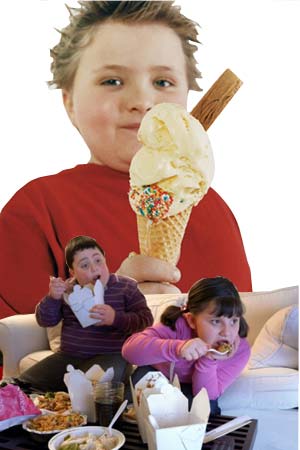Causes of Child Obesity

Earlier, a fat child meant a healthy child, one who was likely to survive the rigors of undernourishment and infection. In the past decade however, excessive fat has become one of the primary childhood health problems. Obesity is defined as excessive accumulation of body fat. Today obesity in children and adolescents has become a serious issue especially in the United States, with over 25 % of children considered obese.
The statistics for childhood obesity are alarming - while 4% children were overweight in 1982, there were 16% overweight in 1994. According to the 2001 figures, nearly 25% of white children and 33% of African American and Hispanic children were overweight. In fact the hospital costs associated with obesity in children were escalating.
Child obesity can lead to many complications. Obesity in children may result in many emotional and physical problems. Emotional problems include altered body image, depression and poor self-esteem. Let us examine the possible causes of increasing obesity in children and how it can be overcome.
Obesity in Child
A child is considered obese based on his/her height and weight, which is compared on a growth chart by a physician. If the normal body weight exceeds the ideal weight in comparison to the age and height then the child is called obese. Child obesity is calculated using BMI (Body mass index), which is a measure of the body fat based on height and weight.
BMI is the measurement of choice for many physicians and researchers studying obesity. BMI uses a mathematical formula that takes into account, both a person's height and weight. BMI equals a person's weight in kilograms divided by height in meters squared (BMI=kg/m2). BMI is the common choice for many physician and researchers studying obesity.
BMI = weight in kilograms / (height in meters x height in meters)
This is what the child's BMI can indicate:
- A BMI of less than 19 - underweight
- A BMI of 19-24.9 - normal weight.
- A BMI of 25-29.9 - overweight.
- A BMI of 30+ - denotes obesity.
Obesity Chart
The following table is the result of research conducted by International obesity task force. It represents the age, obesity and overweight ratio in children of varying age.
| Age (years) | Overweight is a BMI greater than | Obese is a BMI greater than: | ||
| Boys | Girls | Boys | Girls | |
| 2 | 18.41 | 18.02 | 20.09 | 19.81 |
| 2.5 | 18.13 | 17.76 | 19.80 | 19.55 |
| 3 | 17.89 | 17.56 | 19.57 | 19.36 |
| 3.5 | 17.69 | 17.40 | 19.39 | 19.23 |
| 4 | 17.55 | 17.28 | 19.29 | 19.15 |
| 4.5 | 17.47 | 17.19 | 19.26 | 19.12 |
| 5 | 17.42 | 17.15 | 19.30 | 19.17 |
| 5.5 | 17.45 | 17.20 | 19.47 | 19.34 |
| 6 | 17.55 | 17.34 | 19.78 | 19.65 |
| 6.5 | 17.71 | 17.53 | 20.23 | 20.08 |
| 7 | 17.92 | 17.75 | 20.63 | 20.51 |
| 7.5 | 18.16 | 18.03 | 21.09 | 21.01 |
| 8 | 18.44 | 18.35 | 21.60 | 21.57 |
| 8.5 | 18.76 | 18.69 | 22.17 | 22.18 |
| 9 | 19.10 | 19.07 | 22.77 | 22.81 |
| 9.5 | 19.46 | 19.45 | 23.39 | 23.46 |
| 10 | 19.84 | 19.86 | 24.00 | 24.11 |
| 10.5 | 20.20 | 20.29 | 24.57 | 24.77 |
| 11 | 20.55 | 20.74 | 25.10 | 25.42 |
| 11.5 | 20.89 | 21.20 | 25.58 | 26.05 |
| 12 | 21.22 | 21.68 | 26.02 | 26.67 |
| 12.5 | 21.56 | 22.14 | 26.43 | 27.24 |
| 13 | 21.91 | 22.58 | 26.84 | 27.76 |
| 13.5 | 22.27 | 22.98 | 27.25 | 28.20 |
| 14 | 22.62 | 23.34 | 27.63 | 28.57 |
| 14.5 | 22.96 | 23.66 | 27.98 | 28.87 |
| 15 | 23.29 | 23.94 | 28.30 | 29.11 |
| 15.5 | 23.60 | 24.17 | 28.60 | 29.29 |
| 16 | 23.90 | 24.37 | 28.88 | 29.43 |
| 16.5 | 24.19 | 24.54 | 29.14 | 29.56 |
| 17 | 24.46 | 24.70 | 29.41 | 29.69 |
| 17.5 | 24.73 | 24.85 | 29.70 | 29.84 |
| 18 | 25 | 25 | 30 | 30 |
If you think your child is obese, take him/her to a physician. Growth charts are comparison charts used by physicians to assess the growth of a child - both height and weight. Most physicians use the growth charts from the Centers for Disease Control and Prevention (CDC), which is based on the measurements of thousands of children.
These growth charts enable the physician to watch the child's body changes over time. The measured BMI of the child is plotted on the growth chart - 95 percentile is considered overweight or obese. A child who falls between the 85 percentile and 95 percentile is considered at risk for becoming overweight. The American Obesity Association uses the 85th percentile of BMI as a reference point for overweight and the 95th percentile for obesity.
Causes of child Obesity
There are many factors that contribute to obesity among child. Body weights are determined by a combination of these factors. Bad eating habits and lack of exercise are noted as primary causes of increasing obesity among children.
Genetic Factors: Obesity can be genetic i.e. the risk of becoming obese is greatest among children who have obese parents. This is due to the genetic factors or parental modeling of both eating and exercise behaviors.
Environmental Factors: Environmental factors including lifestyle play a major role in child obesity. Poor eating habits, especially consumption of high calorie snacks can cause obesity in children. Some research also shows that extensive viewing of television may cause obesity in children (Dietz and Gortmaker, 1985). Factors involved here are displacement of physical activity coupled with increased calorie consumption caused by the effects of television advertising.
Psychological Factors: Psychological factors also contribute to obesity in children. These factors influence child's eating habits and many people eat in response to negative emotions such as boredom, sadness or anger.
Illness may also lead to obesity or a tendency to gain weight in a child. These include hypothyroidism, Cushing's syndrome, depression and certain neurological problems that can lead to overeating. Also, drugs such as steroids and some antidepressants may cause weight gain. A physician can tell whether there are underlying medical conditions that are causing weight gain or making weight loss difficult.
Obesity can complicate the treatment and management of diabetes and can even lead to the body developing a resistance to insulin. Obese children may have greater difficulty with high blood pressure, high cholesterol levels, orthopedic problems, sleeping habits, as well as self-esteem and peer relationships. Obese children have also known to display symptoms of attention deficit disorder.
Treatment of Obesity in Children
Obesity treatment programs for children aim at slowing or halting weight gain so that the child will grow into his/her body weight over a period of months to years. Research explains that for every 20 % excess ideal body weight, the child will need one to one-half years of weight maintenance to attain ideal body weight. Physical activity and exercise is the best way to prevent and treat obesity in children.
Obese treatment programs include behavioral therapy, reduction in sedentary behavior and nutrition and physical activity education. Give your children a balanced diet. Most children are influenced by their parent's behavior. So, if you follow a regular exercise regimen and follow healthy eating habits, chances are that your children will follow suit.
Tips for Parents
Parents play a pivotal role in treating an obese child. Parents should exercise control over their children's diet. Always have healthy fruits, food and snacks available to your children. Limit sweetened beverages, including those containing fruit juice, as they make your child feel too full to eat healthier foods. Limit white carbohydrates to reduce obesity in your children including rice, pasta, bleached bread and sugar (desserts). Select recipes and methods of cooking that are lower in fat. For example, bake chicken instead of frying it. Ensure that you drink enough water so that you set a good example. Monitor the child's growth pattern.
Take the assistance of a doctor to understand the growth curves giving percentiles for height, weight and body mass index (BMI). Ensure that your family has healthy habits, as obesity is not only the child's problem but is in fact a situation that needs the support of the entire family. Ensuring a good eating routine and fixed meal times for kids is the first step. Children then become hungry at regular times. Three meals and two snacks are just right for a child's day. Don't serve huge portions to your child. Let the child ask for more.
Prevention of Childhood Obesity
Parent education is one of the best ways to prevent obesity in children. Preventing obesity is far easier than treating it. Parent education should focus on promotion of breastfeeding, recognition of signals of satiety, selection of low-fat snacks, good exercise habits and monitoring of television viewing.
Top of the Page: Causes of Child Obesity
Tags:#child obesity #obesity in child #child obesity statistics #cause of obesity in child #obesity among child #cause of child obesity
 Parenting
Parenting Stages of Growth
Precocious Puberty
Nutrition for Kids
Developmental Milestone
Empty Nest Syndrome
Infants
Sudden Infant Death Syndrome
Infant Gas Drops
Milk Allergy in Infants
Infant Reflux
Infant Nutrition
Infant Bathing
Infant Toy
Infant Colic
RSV in Infants
Asthma in Infants
Infant Brain Development
Babies
Baby Milestone
Baby Teething
Toddler Food Recipe
Baby Nursery Furniture
Baby Food Tip
Baby Monitor
Baby Burping
Children Care
 Regular Bedtime for Toddlers
Regular Bedtime for Toddlers Child Care
Kid Summer Camp
Kid Gym
Tween Parenting
Benefits of Breastfeeding
Oppositional Defiance Disorder
Attention Deficit Hyperactivity Disorder - ADHD
Kid Homework Help
Fine Motor Skill
Family Parenting
Single Parenting
Specialty Toy
Child Playhouse
Playgroup
Causes of Child Obesity
Autistic Child
Learning Disability
Toddler Activity
Activities for Toddlers
Child Safety Tip
Child Safety on the Net
Allergies in Toddlers
Top of the Page: Causes of Child Obesity
Popularity Index: 101,167

